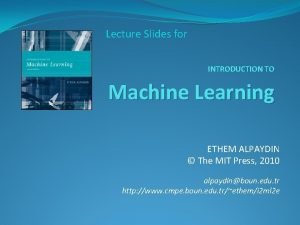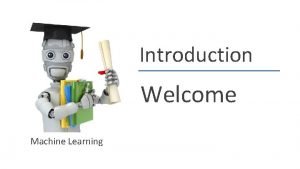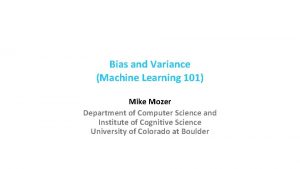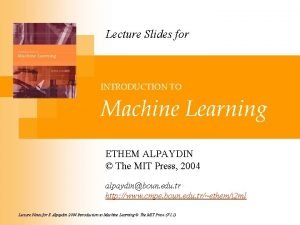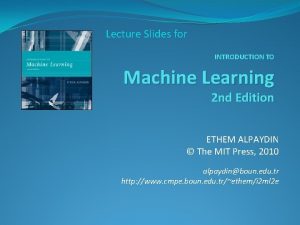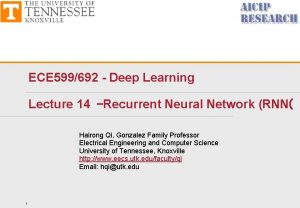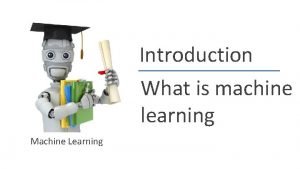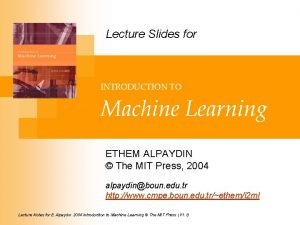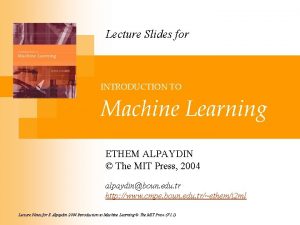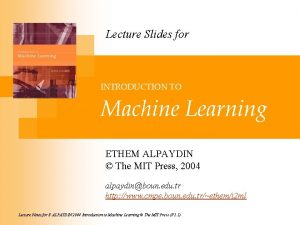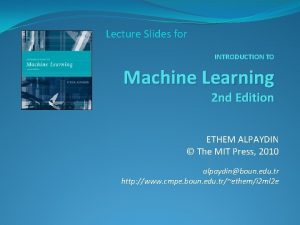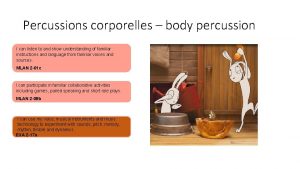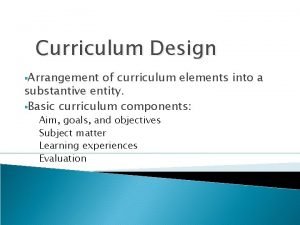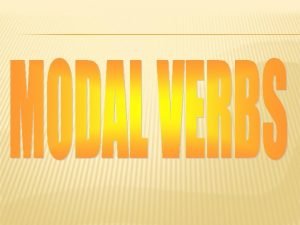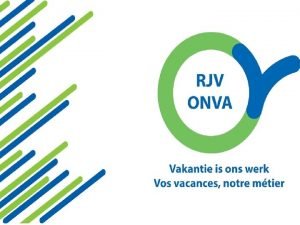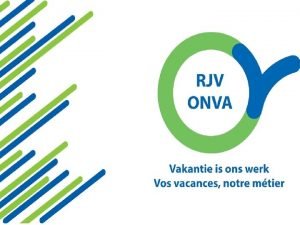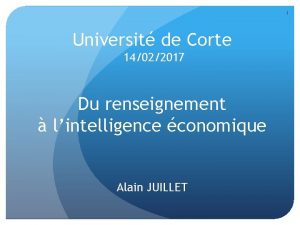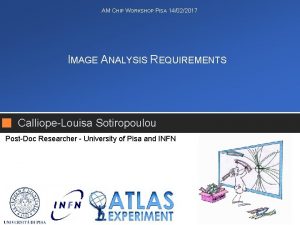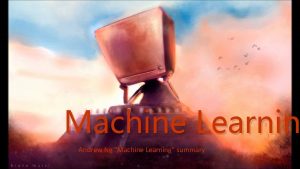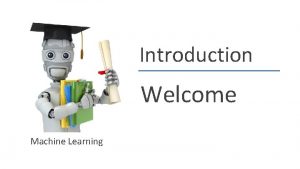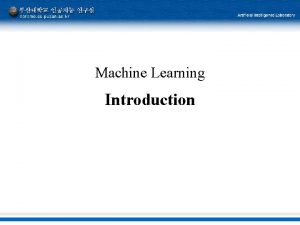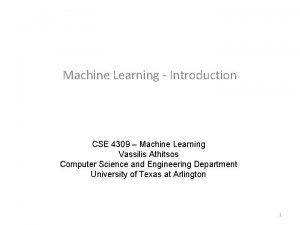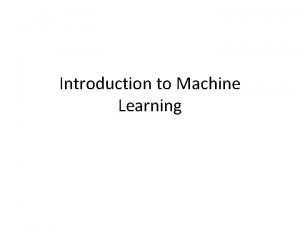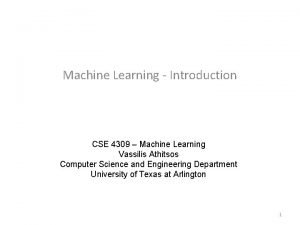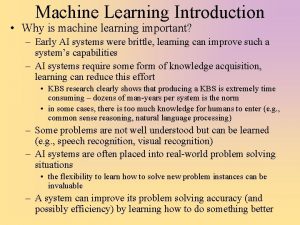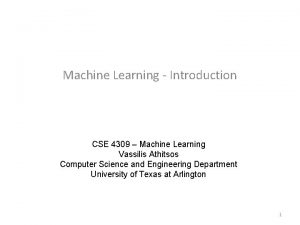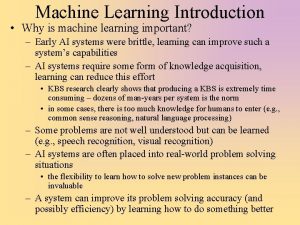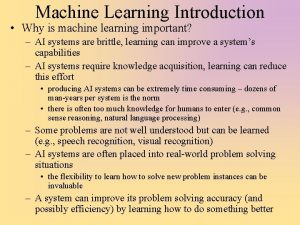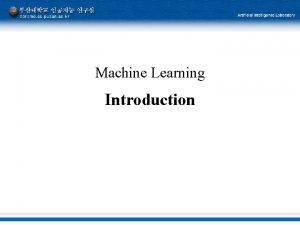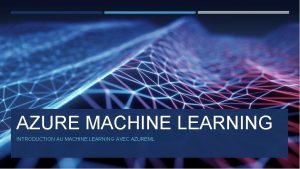Introduction Machine Learning 14022017 Machine Learning How can



































- Slides: 35

Introduction Machine Learning 14/02/2017

Machine Learning How can we design a computer system whose performance improves by learning from experience?

Spam filtering

Face/person recognition demo

Recommendation systems

Robotics

Natural Language Processing

other application areas – Biometrics – Object recognition on images – DNA seqencing – Financial data mining/prediction – Process mining and optimisation Pattern Classification, Chapter 1

Big Data

Rule-based systems vs. Machine learning • Domain expert is needed for – writing rules OR – giving training sample • Which one is better? – Can the expert design rule-based systems? – Is the problem specific or general? 10

http: //www. ml-class. org/course


Most of the materials in these slides were taken from Pattern Classification (2 nd ed) by R. O. Duda, P. E. Hart and D. G. Stork, John Wiley & Sons, 2000 with the permission of the authors and the publisher

14 Definition Machine Learning (Mitchell): „a computer program said to learn from experience E with respect to some class of tasks T and performance measure P, if its performance at tasks in T, as measured by P, improves with experience E. ”

15 Example Classify fishes see bass Classes salmon Goal: to learn a modell from training data which can categorise fishes (eg. salmons are shorter) Pattern Classification, Chapter 1

16 Classification(T) – Supervised learning: Based on training examples (E), learn a modell which works fine on previously unseen examples. – Classification: a supervised learning task of categorisation of entities into predefined set of classes Pattern Classification, Chapter 1

17 Pattern Classification, Chapter 1

Basic definitions Feature (or attribute) Instance (or entity, sample) ID Length (cm) Lightness Type 1 28 0. 5 salmon 2 23 0. 7 salmon 3 17 0. 5 sea bass Class label

19 Example Preprocessing – Image processing steps • E. g segmentation of fish contour and background – Feature extraction • Extraction of features/attributes from images which are atomic variables • Typically numerical or categorical Pattern Classification, Chapter 1

20 Example features • • • length lightness width number of paddles position of mouth Pattern Classification, Chapter 1

21 Length is a weak discriminator of fish types. Pattern Classification, Chapter 1

22 Lightness is better Pattern Classification, Chapter 1

23 Performance evaluation (P) – most simple: accuracy (correct rate) – False positive/negative errors – E. g. if the threshold is decreased the number of sea basses falsly classified to salmon decreases Decision theory Pattern Classification, Chapter 1

24 Feature vector A vector of features describing a particular instance. Instance. A x. T = [x 1, x 2] Lightness Width Pattern Classification, Chapter 1

25 Pattern Classification, Chapter 1

26 Feature space Be careful by adding to many features – noisy features (eg. measurement errors) – Unnecessary (pl. information content is similar to other feature) We need features which might have discriminative power. Feature set engineering is highly taskspecific! Pattern Classification, Chapter 1

27 This is not ideal. Remember supervised learning principle! Pattern Classification, Chapter 1

28 Pattern Classification, Chapter 1

29 Modell selection • Number of features? • Complexity of the task? • Classifier speed? • Task and data-dependent! Pattern Classification, Chapter 1

The machine learning lifecycle • • • 30 Data preparation Feature engineering Modell selection Modell training Performance evaluation Pattern Classification, Chapter 1

31 Data preparation Do we know whether we collected enough and representative sample for training a system? Pattern Classification, Chapter 1

32 Modell selection and training – These topics are the foci of this course – Investigate the data for modell selection! No free lunch! Pattern Classification, Chapter 1

33 Performance evaluation • There are various evaluation metrics • Simulation of supervised learning: 1. split your data into two parts 2. train your modell on the training set 3. predict and evaluate your modell on the test set (unknow during training) Pattern Classification, Chapter 1

34 Topics of the course • • Classification Regression Clustering Recommendation systems Learning to rank Structure prediction Reinforcement learning

https: //www. kaggle. com/competitions http: //www 195. pair. com/mik 3 hall/weka_kaggle. html
 Ethem alpaydin
Ethem alpaydin Andrew ng introduction to machine learning
Andrew ng introduction to machine learning Andrew ng introduction to machine learning
Andrew ng introduction to machine learning High bias low variance introduction to machine learning
High bias low variance introduction to machine learning Machine learning ethem
Machine learning ethem Ethem alpaydin
Ethem alpaydin Introduction to machine learning slides
Introduction to machine learning slides Introduction to azure ml
Introduction to azure ml Lstm lecture
Lstm lecture Andrew ng introduction to machine learning
Andrew ng introduction to machine learning Ethem alpaydin
Ethem alpaydin Introduction to machine learning ethem alpaydin
Introduction to machine learning ethem alpaydin Machine learning ethem
Machine learning ethem Machine learning lecture notes
Machine learning lecture notes Concept learning task in machine learning
Concept learning task in machine learning Analytical learning in machine learning
Analytical learning in machine learning Pac learning model in machine learning
Pac learning model in machine learning Machine learning t mitchell
Machine learning t mitchell Inductive vs analytical learning
Inductive vs analytical learning Combining inductive and analytical learning
Combining inductive and analytical learning Instance based learning in machine learning
Instance based learning in machine learning Inductive learning machine learning
Inductive learning machine learning First order rule learning in machine learning
First order rule learning in machine learning Eager learner and lazy learner
Eager learner and lazy learner Deep learning vs machine learning
Deep learning vs machine learning Cuadro comparativo de e-learning
Cuadro comparativo de e-learning If you can imagine it you can achieve it
If you can imagine it you can achieve it You can tell harris about it just ____(easily) as i can.
You can tell harris about it just ____(easily) as i can. If you think you can you can poem
If you think you can you can poem If you cannot measure it you cannot manage it
If you cannot measure it you cannot manage it If you can't measure it, you can't manage it
If you can't measure it, you can't manage it Percussions corporelles
Percussions corporelles The elements of curriculum design
The elements of curriculum design You can tell harris about it just ____(easily) as i can.
You can tell harris about it just ____(easily) as i can. Comparative and superlative for less
Comparative and superlative for less I cant but he can
I cant but he can
